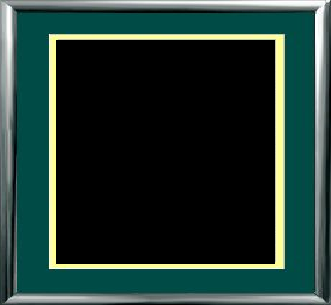|
|
|
Researchers Report Creating Largest-Ever JPEG ImageOver the Reuters Rootin' Tootin' News Service The world's largest JPEG image is being kept on magnetic tape in a research laboratory in Palo Alto, California, informants reported this Tuesday. The image measures 2,147,483,647 pixels wide by 2,147,483,647 pixels tall, and contains nothing but the color black. Pixels are the smallest element of a graphics picture that computer monitors display, corresponding to a single dot on your screen.
 The new Palo Alto image, scaled way, way down, in a nice picture frame. If you wanted to print out the entire image on your new 600-dpi (dot per inch) laser printer, you'd need a sheet of paper over 50 miles-by-50 miles. "Though why, of course, you'd want to waste all of the toner is beyond me," Dr. Whoobint of the Palo Alto Institute for Really Useless Things commented. "You might as well use paint." The image represents an advance in photographic technology, also, as each pixel corresponds to a real-world space about the width of a photon at the shutter aperture. In other words, Dr. Whoobint explained, "this picture contains absolutely all of the resolution that it's going to get." When asked why he and the Palo Alto team that sampled the revolutionary (and huge) image chose JPEG compression, Dr. Whoobint answered, "It offers superior image data compression with a minimal loss in information across the entire color space." When he was informed by a savvy janitor listening in that the monochrome image could have been coded as a PNG (another graphics file format) efficiently with no data loss whatsoever, he mumbled something below his breath and continued, "Creating image files that big makes me a really sexy man, does it not?" The desire to create bigger and better quality images is nothing new. The incredibly huge image by the Palo Alto team only represents the latest development in a crazed race to produce the finest-resolution image. In 1987, for example, the Image Synthesis team of the University of Mississippi Cheerleaders Group, sponsored by Budweiser, sampled a 144000-by-144000 pixel image of the U of M swimsuit competition, in GIF format. They were promptly sued by Unisys and Compuserve, in a startling case that ended in an out-of-court settlement, in which the Group voluntarily gave up their ability to say the word "sporadically". But, still, from the Joe down the street showing off his new 115600-dpi flatbed scanner to the Goodard Observatory scientists sampling 4 million-by-4 million pixel images of distant galaxies as revealed by the Hubble Telescope, really ridiculously big images are all the rage. A spokesperson for the Joint Photographer's Expert Group failed to comment about any of this, but instead swallowed an asprin pill and muttered something about "JPEG is not meant for nonrealistic images like line drawings and cartoons." Speaks John Hartford of Hartford Computers in Biloxi, Mississippi: "Oh yeah, oh yeah, the higher the resolution is, the better, you know? You gotta be able to make really really big posters, you know? I love to be able to see dots! I love to see the spots! And if you've gotta leave the room and look back away from a distance at your 720 inch monitor to see what the hell it is you're looking at, so much the better. Life is beautiful!" But some less enthusiastic and more philosophical observers are beginning to question the utility of the technology used to create these extremely huge computer graphics. If you create an image with a number of pixels higher than human beings can comprehend, is there some danger of causing a brain freeze, a condition which some have coined "pixel overload?" Is the content of the image really less important than its spacial dimensions? When questioned what, exactly, the Palo Alto image represented, Dr. Whoobint explained: "It is an extremely high-resolution photograph of a black bear deep in a coal mine at midnight at new moon. Either that, or it's a piece of licorice candy hiding under the sand at the bottom of the deep sea. We haven't decided. It doesn't really matter though, because, as everyone knows, the content of an image is really less important than its spacial dimensions."
When asked why on earth Palo Alto or anybody else in the world would want to keep such a huge image containing absolutely nothing, "I don't know," was his candid response. "But we've satisfied that compelling urge that's been burning deep in the britches of every member of our Institute. We have really created a utterly, mouth-gapingly huge full 48-bit color rendition of what some gearheads call a 'null matrix'. Three Cray II workstations gave their lives for that image. People compute millions of digits of Pi, give up an immense number of clock cycles for SETI@Home; this is the same kind of thing, don't you know. "But we've won the race, you see, so far is JPEG is concerned. It's written into the spec, you know. The Palo Alto image is the very largest a JPEG image can legally be. Nobody will make one any bigger." |
|
Return to Codehappy.net |